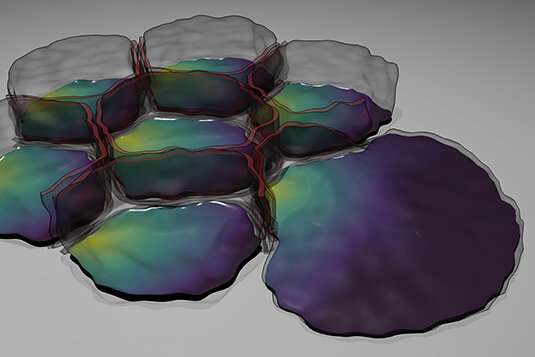How cells muster and march out

Many of the cell types in our bodies are constantly on the move. LMU physicists have developed a mathematical model that describes, for the first time, how single-cell migration can coalesce into coordinated movements of cohorts of cells.
Many vital biological processes, such as growth, wound healing and immune responses to pathogens, require the active movement of cells. Inflammation and metastasis also involve the migration of specific kinds of cells through tissues to distant sites. A detailed understanding of the mechanisms that underlie cell migration—of single cells and small cohorts of cells, and the coordinated locomotion of tissue-level cell collectives—promises to elucidate the basis for one of the fundamental properties of cells. A team of researchers led by LMU theoretical physicist Erwin Frey (Professor of Statistical Physics and Biophysics at LMU) has now developed a new model, which is capable of describing, on both microscopic and macroscopic scales, the motions of cells on planar surfaces, which yields new insights into the collective dynamics of cells. The authors report their findings in the online journal eLife.
Many models have been constructed that seek to account for either the dynamics of single cells or the motions of cell sheets. However, the integration of both approaches into a single model presents a considerable challenge. This is largely because the levels of abstraction needed to capture the requisite phenomenology vary widely, owing to the differences in scale involved. The theoretical model constructed by Frey and his students is specifically designed to close the gap between the paradigms that have been applied to the analysis of cell locomotion at both single-cell and the multicellular scales. It does so by representing the interaction of cells with the underlying substrate in terms of a honeycomb lattice of contact sites, while also taking adhesive contacts between cells into account. "In contrast to the typically macroscopic approaches to the modeling of locomotion at the tissue level, our model explicitly incorporates the relevant properties of the individual cells, such as cell polarization, the structure of the cytoskeleton and the ability to actively reconfigure cytoskeletal organization in response to mechanical cues," explains Andriy Goychuk, joint first author of the paper. "Nonetheless, unlike strategies that depend on the microscopic analysis of shape changes in single cells, which are computationally costly, our framework is entirely rule-based and efficient enough to make simulations at the tissue level possible."
As the new study shows, the model can be used to investigate the migratory behavior of single cells, the transition to collective cell motion, and the coordinated movement of advancing epithelial sheets consisting of several thousands of cells that is involved in wound repair. The analyses and simulations based on the model uncovered links between specific cellular parameters and characteristic patterns of movement, which accurately reflect the experimental findings. Among other things, the authors found that the forces exerted by the cytoskeleton at cell-substrate contact sites and the contractility of the cytoskeletal network on the inner face of the cell membrane both play vital roles in locomotory behavior. In addition, there is a defined relationship between the expansion of cells owing to mechanical pressure within a monolayer and density-dependent cell growth, which leads to specific patterns of multicellular migration. "Our results constitute a considerable advance in our understanding of collective migration on flat substrates," says Frey. "Furthermore, our new model provides us with a highly flexible instrument for studying the migratory behavior of cells of a wide range of contexts, and a very versatile research tool for further studies in this field."
More information: Florian Thüroff et al. Bridging the gap between single-cell migration and collective dynamics, eLife (2019). DOI: 10.7554/eLife.46842
Journal information: eLife
Provided by Ludwig Maximilian University of Munich



















